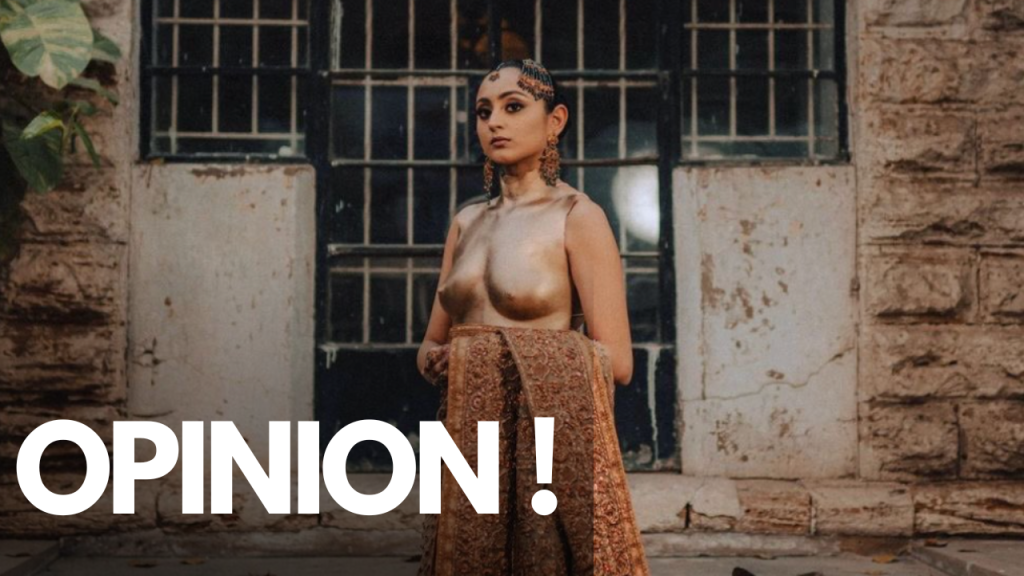Introduction
The last few decades have witnessed a rise in individual artists from around the world to create work based on themes of cultural identity, social struggle and complex dialogue between tradition/modernity in different places. Misha Japanwala is one of them, a Pakistani artist and more recently fashion designer who has made her name through bold sculptural works using body casts to deliver nuanced understandings on ideas surrounding identity, beauty standards and cultural taboos. While Japanwala’s work, visually engaging and lauded in elite circles presents a compelling case for examining the tensions between authenticity, cultural commodification, and the aesthetics of the “exotic East.” This essay takes a critical look at how Japanwala falls within these dynamics, investigating the sincerity of her practice as well whom is likely to critically engage with it given it is very much rooted in her privilege.

The Aesthetics of the Exotic
Japanwala’s art, with its bold portrayal of the human form, plays into the trope of the “exotic East” that has long fascinated Western audiences. The appeal of “otherness” and the allure of the forbidden often shape how non-Western art is received in global cultural centres. By addressing themes such as nudity and conservatism within a Pakistani context, her work taps into a familiar narrative that positions her as a voice speaking out against cultural repression. However, there is a discernible pattern where artists, often from privileged backgrounds, find themselves in the spotlight for presenting narratives that cater to Western expectations of exoticism and cultural “liberation.”

In Japanwala’s own case, the action of representing female forms by using body casts only adds to this aesthetic while ensuring that confrontation is never fully achieved. Body casts basically stripped relevant identity of its clothes which was quite a good choice over showing naked flesh that would fly aggressively in the face line while blending perfectly with what can be posted on an app like Instagram. This calculated approach not only navigates her work through social media visibility but situates it within a Western discourse of female liberation. Her shots are meticulously composed, matching seamlessly with the perfectly curated grids of Instagram; an artful slight-of-hand which perhaps mutes some of the emotional rawness or sincerity from her sociopolitically charged work.
The Role of Privilege and Social Mobility
Yet it is that privileged background of Japanwala, an inescapable factor which informs not just her perspective but the course of where her career is heading at. Japanwala was raised in Karachi and Islamabad and educated at Parsons School of Design, NY — the kind of lineage that comes with cultural/social capital required to move effortlessly between art-world, fashion culture and international exposure. It is a privilege that lends her the freedom to interact with, and interrogate conservative social norms — not necessarily without fear of reprisal or retribution but certainly enough wiggle room for broader expression. Cultural and religious conservatism is a reality many women in Pakistan grow up with, becoming an integral part of who they are; shaping them into individuals whose entire existence AND identity is defined by an ideology that promotes anything but personal freedoms. Whether Japanwala has directly faced this herself is questionable — her socioeconomic status makes it somewhat unlikely, as does the fact that she’s able to live and work outside of South Asia.
This raises concerns about the authenticity of her artistic expression. Could an artist truly address the experiences of repression or conservatism if he/she lived most his/her life free from the social conditions causing that oppression? The gap between Japanwala’s lived experiences and the narratives she presents can create a sense of dissonance, where the issues addressed are more aligned with what sells in the art market than with a call for a sincere social change. The profit to be made from catering such narratives as “cultural critique” for an elite audience operates easily and autonomously, reducing the multifaceted social realities behind these aesthetic motifs. This further serves the interests of an art world that thrives on the consumption of cultural difference.
Subversion in Elite Spaces
Japanwala, like so many others straddling cultural worlds whose work is pigeonholed into either white-cube galleries or fashion showrooms and international platforms far from the socio-political realities they want to tackle. And while her art draws attention to issues of body autonomy, censorship and cultural repression (definitely), the ways in which we consume it could also be negating its subversive potential. The same audiences that laud her for facing down these cultural taboos may well be more into the “exotic” spectacle than a real engagement with THE ISSUES. In such rarefied conditions, the use of art generally becomes about product and quantity over conversation or change.

The irony is palpable: a work of art that aims to unsettle ideas about modesty and body image remains the purview first and foremost of those who have both time— but more importantly — an opportunity at critical distance. Her cleanly cast body casts are somewhat naked, sexy enough to be provocative (suggested by the criticism through the comments on the posts) but not so anatomically explicit as to break any Victorian-era cultural taboos. The art thus becomes a carefully curated performance of subversion, one that conforms to the aesthetics and expectations of a globalised art market while offering the appearance of cultural critique.
A Strategic Balance: Navigating Social Media and Cultural Discourse
Japanwala has taken her practices to the realm of social media—especially Instagram—in a way that is at once strategic and thoughtful, melding the visual language of contemporary art with fashion aesthetics. It helps her work be accessible to the masses but also locates it within a highly visual, commodified effort. On platforms like Instagram, art can quickly become subsumed by the need for visual impact and shareability. The body casts — with their just-right mix of nudity and abstraction — slid in seamlessly, dangling a tempting amount to pique interest without toppling over into supposedly inappropriate territory.

In doing so, Japanwala transforms her artwork into a commercially successful while remaining within the parameters of what is commercially viable. By opting for body casts instead of photographs that actually portray nudity, she could be seen navigating around censorship while still touching subjects related to the politics and history of bodies. However, it also raises questions about the sincerity of this engagement, as the art ultimately conforms to market demands rather than challenging them.
Conclusion: Art, Irony, and the Question of Sincerity
While the work of Misha Japanwala is undoubtedly striking and visually striking, her practice can be seen to represent this larger impulse within contemporary art where cultural syncretic narratives are being produced for a transnational elite. Her work occupies a space in between subversion and conformity that is able to manage the tension between cultural critique and market success. Claiming to discuss important issues of bodily control and cultural sexism, she packages these critiques for the Western audiences in a body that is apparently more appealing or desirable within the Eurocentric visual arts markets. Her privileged background further complicates the authenticity of her narrative, raising questions about whether her art genuinely confronts the issues it purports to address or merely repackages them for a global audience seeking the allure of the “exotic East.” To consider Japanwala’s work carefully is to be constantly aware about how art can function as a site for resistance and yet, also a commodity. The struggle is to identify if her work does more than deliver an aesthetic surface understanding; using the things that are political performative — but reinforcing a marketable sense of being culturally subversive artist only.
Ultimately, Japanwala’s art may be seen as a challenge to societal norms and a reflection of the art world’s fascination with the spectacle of difference—an irony that speaks to the complexities of navigating authenticity in contemporary cultural discourse.
Feature Image: Misha Japanwala’s bride gown with a breast plate she made herself| Courtesy: sofia/ @SOFIssticated via X.com

Iftikar Ahmed is a New Delhi-based art writer & researcher.





